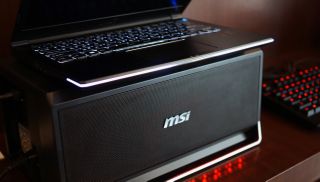MSI and Alienware external graphics enclosures at CES: 2015's laptop trend?

The GTX 980M is the most powerful mobile graphics chip Nvidia has ever made, and the closest to matching the equivalent desktop-caliber graphics card. And yet, for many PC gamers, laptop graphics still don’t cut it. They want the horsepower and overclocking potential of a desktop graphics card. In 2015, both MSI and Alienware are offering a solution to that problem with an external graphics card enclosure—essentially, a small PC case that houses a graphics card and connects to a laptop via PCIe, providing a big boost of GPU power.
This isn’t a new idea, but one of these implementations—MSI’s Gaming Dock Station and Alienware’s Graphics Amplifier—may be the first to make it work.
MSI’s dock looks a bit like an all-in-one printer, but where you’d normally feed in paper, there’s a hinged PCB connector that fits into a slot on the back of the GS30 Shadow, a 13.3-inch ultraportable laptop. Specs-wise, the MSI Gaming Dock Station is a great piece of hardware. It can handle PCIe x16 transfers between the laptop and housed graphics card, which means all (or nearly all) of the GPU’s power will be efficiently utilized. MSI’s proprietary connector isn’t wholly dedicated to PCIe, either. The dock has four USB 3.0 ports, an Ethernet jack, speakers, headphone/mic jacks, and a bay for a 3.5-inch hard drive. And it’s big enough to house pretty much any single-GPU graphics card you throw at it, like an Nvidia GTX 980.
There are downsides to the dock, too. It’s bulky and not especially attractive, but that’s a minor concern. The big problem is that proprietary connector design: right now, it works exclusively with MSI’s GS30 Shadow laptop. MSI says more laptops with the connector are on the way, including some larger size laptops. But I’m not sure they completely thought through the design of the Gaming Dock Station to be future-proof: it fits the GS30 perfectly, but larger laptops will balance awkwardly (if not precariously) on top to fit that rigid connector. A loose PCIe ribbon may have been compatible with a wider array of laptop body types.
The sooner MSI integrates the Dock Station connector with a number of laptops, the better. Initially, it will be available paired with the GS30 Shadow for $2000, and I don’t see many people buying that configuration. But the hardware absolutely has potential.

Alienware’s Graphics Amplifier is the same basic piece of hardware, with a few limitations. Instead of filling 16 PCIe lanes, it can only use 4, which limits the bandwidth of the desktop graphics card. It’s also missing the full-on docking station features of MSI’s dock, with no Ethernet or audio ports, no speakers, and no 3.5-inch drive bay.
MSI’s got the better hardware, but Alienware currently has a leg up on flexibility. The Graphics Amplifier will be available solo for $300, and it’s already compatible with two Alienware laptops, with more on the way.
PC Gamer Newsletter
Sign up to get the best content of the week, and great gaming deals, as picked by the editors.
A few PC companies have tried this idea in the past, using Thunderbolt and other high-speed connectors, but no docking station has caught on just yet. MSI and Alienware aren’t the only ones trying it this year, either: Gigabyte had their own prototype dock on display at CES 2015, too. Will this be the year that external docks really take off? Much as I’d like to see that happen, I’m guessing the answer is no. I think the hardware is finally good enough to enable great graphics performance on an ultraportable laptops, but the docks need to be compatible with more laptops (and probably need to be more affordable) for them to make sense for more gamers.

Wes has been covering games and hardware for more than 10 years, first at tech sites like The Wirecutter and Tested before joining the PC Gamer team in 2014. Wes plays a little bit of everything, but he'll always jump at the chance to cover emulation and Japanese games.
When he's not obsessively optimizing and re-optimizing a tangle of conveyor belts in Satisfactory (it's really becoming a problem), he's probably playing a 20-year-old Final Fantasy or some opaque ASCII roguelike. With a focus on writing and editing features, he seeks out personal stories and in-depth histories from the corners of PC gaming and its niche communities. 50% pizza by volume (deep dish, to be specific).
Most Popular




